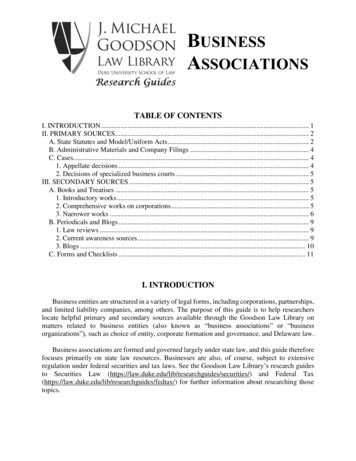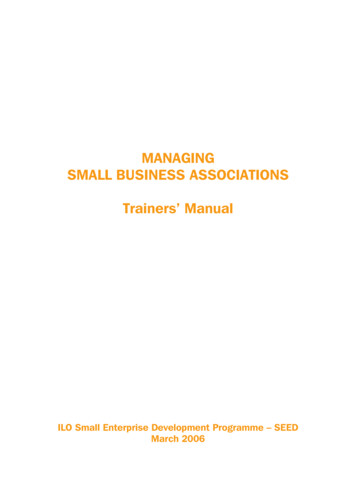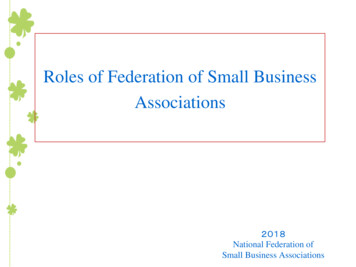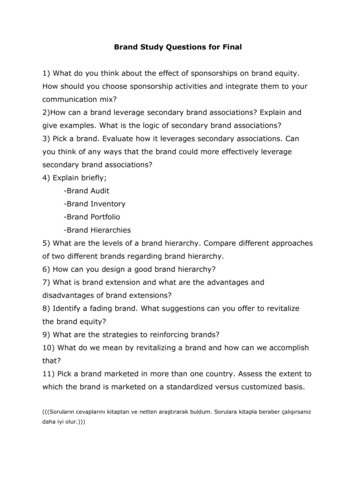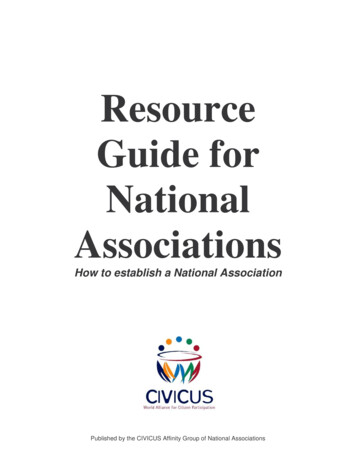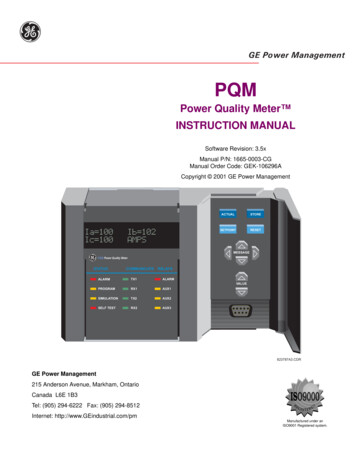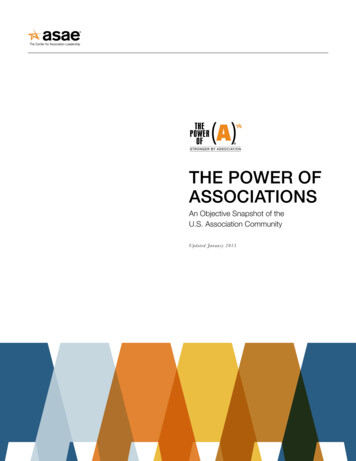
Transcription
THE POWER OFASSOCIATIONSAn Objective Snapshot of theU.S. Association CommunityU pdat e d Jan u ar y 2 0 1 5
as·so·ci·a·tionA GROUPof peopleba ndedtogetherfor aPURPOSE
FOREWORDThe Power of Associations is intended to provide an objectivesnapshot of the U.S. association community—a diverse, vibrantsector and powerful contributor to the United States economy andquality of life. Associations are frequently regarded individually in thecontext of the industry, profession, or cause they represent. Rarelyare they thought of in a collective sense as a broad sector that isenmeshed in the daily patterns of American life and community. Thepurpose of this updated report is to give an overview of the size andscope of association activity in the United States and illustrate itsrelative importance to society.Part of the difficulty in getting a handle on the size of the associationcommunity and its unique contribution to the larger society stemsfrom the complexity of the tax code and the different types ofnonprofit organizations that are granted tax exemption by thefederal government. While there were nearly 1.6 million tax-exemptorganizations recognized by the Internal Revenue Service (IRS) in2013, most associations fall under two tax classifications: Section501(c)(6) and Section 501(c)(3). In 2013, the IRS recognized about67,000 501(c)(6) associations and nearly 1.1 million 501(c)(3) groups.Although associations are formed for a wide range of purposes, theIRS—the federal agency tasked with oversight and enforcement ofthe tax-exempt sector—broadly defines associations as “a group ofpersons banded together for a specific purpose.”A strong sense of community and coordinated activity is at theheart of the profession of association management. People join andvolunteer for associations because they want to work together on acommon cause or interest. America’s associations have deep roots inour history. The first American settlers formed “guilds,” patterned afterBritish trade groups, to address common challenges and supporteach other’s work and lifestyle. This distinctive pattern of coordinated
FOREWORDcon tin u edactivity in the private sector has shaped and advanced theUnited States, and has historically set the country apart frommany other nations (although associations, or “non-governmentalorganizations,” are now growing in number internationally aswell). While the complexity of associations and their role hasevolved, today’s associations still share the purpose of comingtogether to produce positive results.The Power of Associations relies on United States governmentstatistics and tax-exempt returns (Form 990s) to provide astatistically precise overview of the association community.These statistics focus primarily on employment, wages,revenues, and assets. Where possible, we also cite recent ASAEstudies that document trends in associations that are relevantto this report. By no means is this report a comprehensiveassessment of the association sector and its many contributionsto America’s economy and quality of life. But it begins to fill theinformation gap about associations as employers, businesses,membership organizations, and unique contributors to theAmerican experience.Part of ASAE’s mission is to promote a deeper understandingof associations and their role in American society. This reportis intended to help those who are perhaps familiar only withcertain associations gain a better picture of the size and scopeof the broader sector. It may also be interesting reading forthe members and employees of associations who may seethemselves as specialists and not part of a larger, resourceful,and influential community.
associationBY THE NUMBERSan overviewS IZEIN 2013S o u rc e: I R S Data B ookThe IRS recognizedThe IRS recognizedThere were66,9851,052,4951,524trade and professionalassociationscharitable and philanthropicorganizationsnew applications for 501(c)(6) status and45,289applications for 501(c)(3) status filed with the IRS. Thevast majority of these applications were approved.E M P LOY ME N TIN 2013S ourc e: B ureau of Labor S tatisti cs, Qu ar te rl yCensus of Em plo ym ent and Wa ges ( QCEW )States with thehighest membershiporganizationemployment were:Membership organizations*employed more thanCaliforniaNew YorkIllinoisPennsylvaniaFlorida1.3 million*includes religious organizations,grant making and giving services,social advocacy organizations,civic and social organizations,and trade and professionalassociations.If it were a state, the Washington, DCmetropolitan area would rankthirdbehind California and New York in totalmembership organization employment(89,158 employees).Pa ge 5
associationBY THE NUMBERSan overviewWAG E SIN 2013S o u rc e: B u reau of Labor S tatistic s, Quarterl y Census of Emplo yme n t an d Wa ge s ( QCEW )PayrollAnnual WagesMembership organizationsgenerated a payroll of nearlyThe average annual wages for employees of businessassociations and professional societies combined was 51 billion 73,490R E V E N U E AN D A SSE T SIN 2013S ourc e: I RS B usiness Master File, ASAE Fou n dation Association 990 D atabaseTrade and professionalassociations generated 142 billionin revenue, up 13.8 percentover the last five years ( 112billion in 2008)CaliforniaWashington, DCNew YorkMassachusettsTexaslead in association revenuePa ge 6Membership associations hold anestimated 306 billionin assets. Massachusetts-basedassociations hold the most assets (nearly 82 billion), followed by California, NewYork, Pennsylvania, and Washington, DC
OTHE R B E NE FI T SIN 2013Volunteer ServiceNearly63 millionNearly7.7 billionNearlyNumber of Americanswho volunteered through amembership organizationNumber of hours Americansvolunteered altogetherEstimated value of this volunteerservice 174 billionMeetings IndustryAssociations represent a major piece of the meetingsand conventions industry in the United States.1.8 million 280 billionNumber of jobs the meetingsindustry supportsAmount of money accountedfor direct spending byattendeesJob TrainingPa ge 757 million69%Adults in America who takeformal work-related coursesor training each yearIndividuals who receivethose training programs fromeither a private business or aprofessional association.
THE IMPACT OFASSOCIATIONSa summa ryThe Power of Associations documents the unique contributions of membershiporganizations to America’s economy and civic life. Their economic benefitsinclude more than 1.3 million jobs; a total payroll of nearly 51billion; and tangible contributions to national, state, and local economies.A Brie f His t o r ydedicated to furthering the primary purpose for which theywere organized or are subject to unrelated business incometax.Associations are a unique segment of the nonprofit sectorin the United States. The broad nonprofit sector alsoincludes colleges and universities, hospitals, churchesand religious organizations, fraternal societies, veterans’organizations, labor unions, and more.The first integrated federal income tax statute enactedin 1913 provided exemptions for business leagues, asassociations were known at that time. The Revenue Act of1913 also provided exemptions for charitable, scientific, andeducational organizations. Subsequent revenue and taxreform acts in 1950 and 1969 created the contemporarystructure under which associations operate today. Thereare currently nearly 30 different subsections of taxexemption in the United States tax code.Congress first gave associations favored tax treatmentlargely to recognize the public benefits derived from theiractivities. In simple terms, associations earn their taxexempt status by satisfying many of the needs of variousindustries, professions, and the general public that thegovernment would otherwise have to address.Unlike corporations, associations are barred fromaccumulating equity appreciation for private benefit.Instead, these organizations undertake programs orinitiatives to benefit members and the public rather thanprivate individuals. Their earnings, therefore, are eitherWhile some professional societies fall under the 501(c)(3)tax classification, in general, the IRS recognizes trade andprofessional associations under the same tax classification,Section 501(c)(6), because they are organized around eithera common business or professional interest. Trade andprofessional associations may engage in political activitythat relates to accomplishing and protecting their exemptpurpose.Section 501(c)(3) organizations are generally publiclysupported charities or private foundations, though somemembership associations are classified under 501(c)(3).Public charities and private foundations are not completelyrestricted from political activity, but attempts to influencelegislation cannot be a substantial part of their activities.These groups are permitted to engage in certain votereducation activities that are carried out in a non-partisanmanner, but they are restricted from participating inany campaign activity for or against a specific politicalcandidate.Section 501(c)(4) organizations are operated exclusivelyfor the promotion of social welfare. This means that theorganization must operate primarily to further, in some way,the common good and general welfare of the people ofPa g e 8
T h e I mpa c t o f A ssociations: A S um m arycontinuedThe second-largest subsection is 501(c)(4) social welfareorganizations. In 2013, there were 91,056 501(c)(4)organizations registered with the IRS. Campaign financeexperts have attributed the growth in 501(c)(4) registrationsto their ability to conduct political activities related to theirprimary purpose without disclosing their donors. The IRShas said 501(c)(4) groups are playing an increasing role inAmerican politics by using anonymous corporate donationsto finance political ads before elections. Campaign financelaw underwent a significant shift in 2010 when the SupremeCourt ruled in the Citizens United case that the governmentcannot restrict corporate spending in elections, andcorporations, unions, and special-interest groups can usegeneral treasury funds to pay for issue ads running justbefore an election.the community (such as by bringing about civic bettermentand social improvements). These groups may further theirsocial welfare purposes through political activity withoutjeopardizing their exempt status. However, the IRS iscurrently considering new rules that more clearly definehow much political activity is allowable for 501(c)(4) groups.Si ze and Sc o p e of th eAsso c iat io n C om m u n i tyWhile the nonprofit sector remains vast and diverse, itsnumbers have declined in the last five years, mostly due toa new law requiring the IRS to begin automatically revokingthe tax-exempt status of nonprofit groups that do not fileinformation returns for three consecutive years. Before thischange (included in the Pension Protection Act of 2006),smaller tax-exempt organizations with annual revenuesof 25,000 or less were not required to file an annualreturn. While the law successfully cleared many defunctorganizations from the IRS’s books, hundreds of thousandsof smaller groups that were unaware of the change in lawhad their tax-exemption automatically revoked and had toapply for reinstatement. Despite this situation, thousandsof new associations are formed each year. A look at someof the fastest-growing industries in the world today—suchas alternative energy, biotechnology, electronic commerce,and construction — provides strong clues about where wewill see new trade and professional associations forming inthe years ahead.Section 501(c)(6) organizations are the third-largest typeof tax-exemption, according to the IRS. In 2013, therewere 66,985 501(c)(6) organizations on file with the IRS.This subsection includes chambers of commerce and themajority of the trade associations and professional societiesoperating in the United States today.G eog ra p h i c FocusThe 501(c)(3) tax classification is by far the largestsubsection of the tax-exempt community. The IRS had1,052,495 Section 501(c)(3) organizations on file in 2013.This is a very broad subsection of organizations thatincludes everything from public charities and causerelated groups to supporting organizations and grantmaking organizations (including private foundations). Thissubsection also includes educational institutions, museums,and religious organizations (which are not required toregister with the IRS and are not included in the numbersreferenced above.)Primarily due to the presence of the federal government,the Washington, DC metropolitan region is home to a largeconcentration of trade and professional associations, aswell as charities and philanthropic organizations. Nearly3,000 associations and 36,000 other nonprofit groups callthe nation’s capital home. Other metropolitan areas withsignificant numbers of associations include Chicago andNew York City. Looking at data by state, however, showsthat associations are active in communities across thecountry.Pa ge 9
T h e I mpa c t o f A ssociations: A S um m arycontinuedTop States for Registered 501(c)(3)Organizations, 2014CaliforniaTexasNew YorkFloridaIllinoisWashington, DCAssociations are found in every state and territory in thecountry. They are significant job creators, particularly inconcentrated metropolitan regions across the countrysuch as Washington, DC, Chicago, New York, Boston, 661The entire nonprofit sector accounts for 9.2 percent of allwages and salaries paid in the United States. The nonprofitsector’s share of gross domestic product (GDP) was 5.5percent in 2012.S o u rce : I R S B u si n ess M ast e r FileTop States for Registered 501(c)(6) Organizations, 2014CaliforniaTexasIllinoisFloridaNew YorkWashington, DC5,9795,0634,0362,8902,8832,916Em p l o ym entBureau of Labor Statistics data shows that membershiporganizations alone employ more than 1.3 million people(1,331,923). Again, trade and professional associationsare just one segment of the membership organizationcommunity as defined by the federal government (whichalso includes religious organizations, grant making andgiving services, social advocacy organizations, and civicand social organizations).The leading states for association employment were theDistrict of Columbia metro region (36,939 jobs), Illinois(20,167), California (15,057), Virginia (14,736) and Texas(12,115).Top States for Association Employment, 2013Washington, DCIllinoisS o u rce : I R S B u si n ess M ast e r FileCaliforniaVirginaTexasSou rce : Bu re au of Labor StatisticsPa g e 1036,93920,16715,05714,73612,115
T h e I mpa c t o f A ssociations: A S um m arycontinuedAsso c iat io n HQNearly 37,000 residents of the Washington, DC metropolitanarea (including northern Virginia and parts of Maryland)are employed by business associations or professionalorganizations. There are many reasons why the nation’scapital is home to such a dense concentration of tradeand professional associations. Chief among those reasonsis proximity to Congress, the presidential administration,federal agencies and other associations that work ondomestic and international issues of interest to manyassociations’ members.Largest Associations in the Washington, DCMetropolitan AreaAARPMission: Founded in 1958, AARP is a nonprofit,nonpartisan membership organization for people age 50and over. AARP is dedicated to enhancing the quality of lifefor all as we age. AARP leads positive social change anddelivers value to members through information, advocacy,and service.Number of Members:More than 37 millionBudget: 1.4 billionAmerican Chemical SocietyMission: Founded in 1876, the American ChemicalSociety (ACS) is the world’s largest scientific societyand one of the world’s leading sources of authoritativescientific information. A nonprofit organization, chartered byCongress, ACS is at the forefront of the evolving worldwidechemical enterprise and the premier professional homefor chemists, chemical engineers and related professionsaround the globe.Number of Members:More than 161,000National Education AssociationMission: Founded in 1857, the National EducationAssociation is the nation’s largest professional employeeorganization, representing 3.2 million elementary andsecondary teachers, higher education faculty, educationsupport professionals, school administrators, retirededucators and students preparing to become teachers.Number of Members:3.2 millionBudget: 371 millionNational Rifle AssociationMission: Founded in 1871, the National Rifle Associationadvocates for the protection of the Second Amendmentof the U.S. Bill of Rights and the promotion of firearmownership rights as well as marksmanship, firearm safety,and the protection of hunting and self-defense in the UnitedStates.Number of Members:4.5 millionBudget: 256 millionAmerican Diabetes AssociationMission: The mission of the American DiabetesAssociation (ADA) is to prevent and cure diabetes and toimprove the lives of all people affected by diabetes. To fulfillthis mission, the ADA funds research, publishes scientificfindings, provides information and other services to peoplewith diabetes, their families, health professionals and thepublic. The ADA is also actively involved in advocatingfor scientific research and for the rights of people withdiabetes.Number of Members:Budget:N/A 228 millionBudget: 523 millionPa g e 11
T h e I mpa c t o f A ssociations: A S um m arycontinuedWa gesFor years, the prevailing assumption about working in thenonprofit sector was that nonprofit employers generallypaid lower wages than their for-profit counterparts, butwere more likely to compensate employees with otherbenefits or favorable job conditions such as a flexible workschedule. People who work for nonprofits might also obtainsatisfaction from being part of an organization that has analtruistic mission or purpose.Over the past several years, however, employment andwage data compiled by the federal government suggestthat full-time workers in certain subsets of the nonprofitsector are earning more on average than their counterpartsin private industry and government. While that may bea reflection of fewer minimum-wage jobs in trade andprofessional associations, it nevertheless speaks to thequality of opportunities available in certain segments of thetax-exempt sector.According to the 2013 annual average data from the Bureauof Labor Statistics’ Quarterly Census of Employment andWages (QCEW,) full-time workers employed by professionalorganizations and business associations earn more thanprivate industry and government employees.2013 Annual Averages Quarterly Census ofEmployment and Wages by six-digit NAICS code.77,377Business Associations 70,824All private industry 49,701All government 50,380Professional organizations(federal, state and local)Business and Professional Associations’ AverageWage Compared to other Industry Wages, 201395,157Finance/insurance 91,862Professional organizations 77,377Business associations 70,824Manufacturing 61,102Construction 53,181Transportation/Warehousing 47,444UtilitiesSou rce : Bu re au of Labor StatisticsR evenue and AssetsAs evidenced throughout this publication, associations andthe larger nonprofit sector are substantial contributors tothe economy at the national, state, and local levels. In 2012,nonprofit organizations reported more than 1.65 trillion intotal revenues and over 3 trillion in assets.More than half of all nonprofit organizations are registeredas tax-exempt under Section 501(c)(3) of the tax code. Thisbroad subsection of tax-exempt organizations includespublic charities, educational institutions, tax-exempthospitals, museums, and more.Registered associations and public charities with morethan 25,000 in total revenues are required to file a Form990 return annually with the IRS. In 2013, membershipassociations reported 142 billion in total revenue. Totalrevenue includes revenue from contributions, grants,program services, and investment income.S o u rce : B u reau o f Labor S t at i stic sWages in business and professional associations alsocompare very favorably to other industries. For example,employees of professional associations earned an averageannual wage of 77,377 in 2013, which is 21 percenthigher than the annual average wage for the nation’smanufacturing workforce in 2013 at 61,102.Membership associations also held an estimated 306billion in total assets.Pa g e 12
T h e I mpa c t o f A ssociations: A S um m arycontinuedThe top-ranked states by association revenue in 2013 wereCalifornia, Washington, DC, New York, Massachusetts andTexas.Top States by Membership Association Revenue, 2013 51.8 billionWashington, DC 11.3New York 11Massachusetts 8.3Texas 6.4CaliforniaThese meetings are big business for their host cities.Meetings boost hotel room occupancy, generate directspending by attendees, and lead to future business. In2014, the Convention Industry Council released an updatedstudy, The Economic Significance of Meetings to theU.S. Economy, revealing that the United States meetingsindustry directly supports 1.8 million jobs, a 115 billioncontribution to the GDP, 280 billion in direct spending, 67billion in labor revenue, and 28 billion in federal, state andlocal tax revenue.The CIC study quantifies the economic contributions madeby the 1.8 million meetings, trade shows, conventions,congresses, incentive events, and other meetings thattake place across the country. The meeting industry’scontributions to GDP in 2012 were almost 9 percent higherthan they were in 2009, providing more than 115 billionto fuel the U.S. economy. Meetings contribute more to thenation’s economy than air transportation, motion pictures,performing arts and spectator sports.S o u rce : I R S B u si n ess M ast e r FileThe top states by association assets in 2013 wereMassachusetts, California, New York, Pennsylvania,Washington, DC, and Michigan.A total of 225 million people, representing domesticand international delegates, exhibitors, and organizers,attend those 1.8 million meetings. The meetings arevehicles for job training and education, generateg salesrevenue, link domestic and foreign buyers, and fosterlasting relationships in personal environments that buildtrust and unity. Of the 1.8 million meetings, 1.3 million areclassified as corporate or business meetings, 273,700are conventions, conferences or congresses, 10,900 aretrade-shows, and 67,700 are incentive meetings. Thevast majority of meetings (85 percent) were conducted atvenues with lodging. Meetings generate more than 275million overnight stays by attendees.Top States by Membership Association Assets, 2013 81.9 billionCalifornia 33.7New York 28.1Pennsylvania 22.8Washington, DC 20.8MassachusettsS o u rce : I R S B u si n ess M ast e r FileOth er B enef i ts of Associ atio nsE con o mic I m p actBeyond their role as employers, associations make tangiblecontributions to national, state, and local economies. Withtheir focus on professional development and training,associations host a wide range of meetings, seminars,conventions, trade shows, and other events in cities acrossthe United States and abroad.Beyond their direct impact on the economy, associationsprovide numerous other benefits that can be felt incommunities across the United States and worldwide.These public benefits speak to the unique resourcesand expertise in the association sector and the collectivecontributions associations make to society.Pa g e 13
T h e I mpa c t o f A ssociations: A S um m arycontinuedE du c at ing t h e Work forc eAssociations are among the top sources of post-collegetraining and professional development for America’sworkforce. The most recent “Adult Education Survey”conducted by the National Center for Education Statisticsshows that 57 million adults in America take formal workrelated courses or training each year, and more than 69percent of those individuals receive those training programsfrom either a private business or a professional association.Also, more than 46 million adults over 18 report thattheir most recent credential is a license or certification.Credentials are awarded by the government, whilecertifications are typically offered by professionalassociations.ASAE’s own compilation of associations’ financial data,called the Operating Ratio Report, shows that associationsspend far more on average on education programs, tradeshows and conventions (28 percent of total revenue) thanthey do on lobbying activities (6.8 percent of total revenue).Vol unt e e ris mNearly 63 million Americans volunteered through or fora nonprofit organization in 2013. That volunteer rate wassimilar to the rates observed in 2011 and 2012.During the most recent recession, as millions of Americansfound themselves unemployed or saddled with financialuncertainty, there were numerous signs that volunteerismactually increased. Research conducted in 2013 by theCorporation for National and Community Service, anindependent federal agency that fosters civic engagementthrough AmeriCorps, Senior Corps and other serviceopportunities, shows a strong connection betweenvolunteer rates and economic and community factors. Thecorporation’s study Volunteering and Civic Life in Americashows that factors such as home ownership, education,and even commute length all contribute to individuals’ rateof volunteerism.Associations often have missions that engage volunteers.Association members are recruited both to serve inleadership capacities within their trade association orprofessional society, and to contribute their expertise, skills,and time to community-based efforts.In 2008, ASAE published The Decision to Volunteer, acomprehensive examination of the volunteering behavior ofassociation members. The findings were based on a surveyof more than 26,000 respondents who are members of atleast one association. The most commonly cited reasonfor volunteering is a desire to help others and create abetter society. While association members expect careerbenefits from their professional volunteering, they are alsointerested in contributing to a larger cause, such as buildinga stronger profession. The top methods for recruitingvolunteers to associations were through participation inchapters or annual meetings and a direct ask from staffor other volunteers. While ideally suited for involvement,associations face challenges in retaining volunteers.Association volunteers have strong expectations that theywill be involved effectively in an organization and rewardingopportunities to work with other industry professionalson a common cause. The study also showed that thenext generation of association leaders (Millennial andGeneration X members) believes strongly in the importanceof volunteering, but they also have high expectationsregarding their experience.C om m uni ty Ser vi ceOne of the unique attributes of associations is their abilityto effect positive change in society. Beyond their specificmission or purpose, associations are often able to leveragetheir members’ expertise and other resources to address asocial need and improve our collective quality of life. Thereare countless examples throughout America and the worldof associations engaging their members in efforts thatenrich lives and positively affect the global economy.Following are just a few examples of how associationsorganize and channel resources to address some ofAmerica’s and the world’s most pressing problems:American Society for Gastrointestinal EndoscopyDowners Grove, ILAmbassador Prog ramPhysicians around the world have been provided theequipment and supplies necessary to provide advancePa g e 14
T h e I mpa c t o f A ssociations: A S um m arycontinuedendoscopic care to their underserved communities thanksto the efforts of the American Society for GastrointestinalEndoscopy’s (ASGE) Ambassador Program and itsdedicated member-volunteers. ASGE partners withinstitutions and clinics around the world to bring theAmbassador Program to each destination. Equipment andsupplies necessary to carry out the program are providedand gastrointestinal endoscopists conduct training on avoluntary basis. Since 2010, nearly 300 physicians havebeen trained from Nigeria, Kenya, Sudan, Egypt, Vietnam,Ecuador and the Solomon Islands. Up to 10 days oftraining are provided across a number of ailments andtreatments. ASGE’s Ambassador Program has providedready access to advanced medical care techniques tophysicians and international centers in developing countriesthat lack information on therapies in which gastrointestinalendoscopists specialize.American Speech-Language-Hearing AssociationRockville, MDASHA Diversity R ecr uitment Prog ramsThrough its diversity recruitment initiatives, the AmericanSpeech-Language-Hearing Association (ASHA) is helpingto ensure a more culturally competent workforce, aswell as respond to the growing and changing populationwith communication disorders. ASHA’s Minority StudentLeadership Program (MSLP) and Student to EmpoweredProfessional (S.T.E.P.) have greatly enhanced racial andethnic recruitment and retention in the discipline ofhuman communications sciences and disorders. TheMSLP provides students from emerging majorities withopportunities to explore leadership within ASHA, increasetheir awareness of the association’s resources and itsgovernance, and offers networking opportunities withassociation leaders. The S.T.E.P. mentoring programconnects students with experienced mentors in meaningful,one to one mentoring relationships; supports mentoringrelationships through guided learning experiences andonline resources, information, and inspiration; and facilitatesthe continued recruitment and retention of racial/ethnicminority students.Pharmacy Society of WisconsinMadison, WIWisconsin Phar mac y Quality CollaborativePharmacy Society of Wisconsin (PSW)’s WisconsinPharmacy Quality Collaborative (WPQC) is an evidencebased approach to ensure that consume
evolved, today’s associations still share the purpose of coming together to produce positive results. The Power of Associations relies on United States government statistics and tax-exempt returns (Form 990s) to provide a statistically precise overview of the association communit

